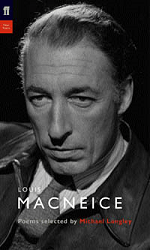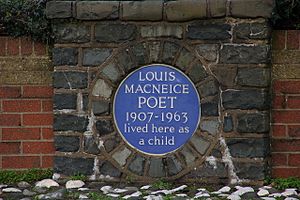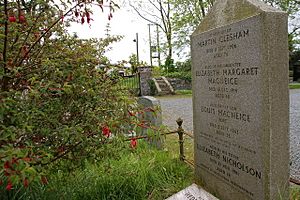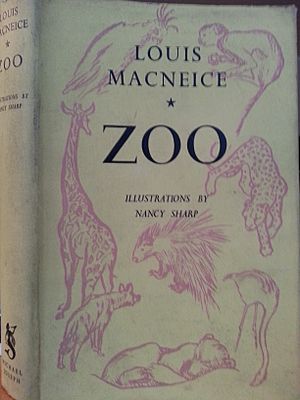Louis MacNeice facts for kids
Quick facts for kids
Louis MacNeice
|
|
|---|---|

MacNeice on the cover of Selected Poems, edited by Michael Longley (1988)
|
|
| Born |
Frederick Louis MacNeice
12 September 1907 Belfast, Ireland
|
| Died | 3 September 1963 (aged 55) London, England
|
| Resting place | Church of Ireland, Carrowdore |
| Citizenship | British |
| Alma mater | University of Oxford, Marlborough College |
| Occupation | Poet |
| Spouse(s) | Hedli Anderson (m. 1942–1960), Mary Ezra (m. 1930–1936) |
| Children | Daniel MacNeice, Corinna MacNeice |
Frederick Louis MacNeice (born September 12, 1907 – died September 3, 1963) was a famous Irish poet and writer of plays. He was part of a group of writers called the Auden Group, which included other well-known poets like W. H. Auden. People really liked MacNeice's writing during his lifetime. His style was easy to read but also showed deep feelings and thoughts about society. He didn't write about politics in a simple way, but he was against unfair governments and always remembered his Irish background.
Contents
Life of Louis MacNeice
Early Years in Ireland (1907–1917)

Louis MacNeice was born in Belfast, Ireland. He was the youngest son of John Frederick and Elizabeth Margaret MacNeice. His father was a church leader who later became a bishop. His mother was a schoolteacher. The family moved to Carrickfergus, County Antrim, soon after Louis was born.
When Louis was six, his mother became very ill and passed away in 1914. This was a sad time for him. His older brother, William, who had special needs, went to live in a special home in Scotland. In 1917, Louis's father married again. Louis and his sister Elizabeth were sent to a special school in England.
School Days (1917–1926)
Louis went to Sherborne Preparatory School in England. He enjoyed learning about old Greek and Latin stories and literature. He also liked sports. In 1921, he moved to Marlborough College. Here, his interest in ancient cultures like Egyptian and Norse mythology grew even more.
He started writing poetry and essays for the school magazines. By the time he left Marlborough, he was very interested in art and literature. In 1925, he won a scholarship to Merton College, Oxford. He left Marlborough in 1926. He stopped using his first name, Frederick, and began using Louis. He also changed his accent and moved away from his father's religious beliefs. However, he always felt connected to his Irish roots.
University Life at Oxford (1926–1930)
At Oxford, Louis met W. H. Auden, who was already a well-known poet at the university. Auden became a lifelong friend and inspired Louis to take poetry seriously. Louis published his poems in student magazines. He also organized poetry readings.
In 1928, he met Mary Ezra. A year later, they decided to get married. Louis's family had some concerns about the marriage. Despite this, Louis published his first collection of poems, Blind Fireworks, in 1929. He dedicated the book to Mary. In 1930, Louis and Mary got married in Oxford. Their parents did not attend the ceremony. Louis earned a top degree in Classics. He then got a job as a lecturer at the University of Birmingham.
Life in Birmingham (1930–1936)
Louis and Mary moved to Birmingham. Louis found it hard to write poetry there. Instead, he wrote a novel called Roundabout Way. He published it under a different name, Louis Malone, because he worried about how a professor's novel would be received. He felt that being married was not helping his poetry.
By 1932, Louis and Auden became very close friends. Louis was interested in ideas about changing society, but he was careful about extreme political views. He didn't agree with some of his friends who became communists.
Louis started writing poetry again. In 1933, he and Auden helped start a new magazine called New Verse. Louis also sent poems to the famous poet T. S. Eliot. Many of his poems were published in Eliot's magazine, The Criterion. On May 15, 1934, Louis and Mary's son, Daniel John MacNeice, was born. In 1935, Louis published Poems, his first collection with Faber and Faber, who would publish many of his future books. This book helped him become known as one of the important new poets of the 1930s.
In November 1935, Mary left Louis and their young son. Louis hired a nurse to help care for Daniel. His sister and stepmother also helped sometimes. In early 1936, Louis visited Spain. Later that summer, he and Auden traveled to Iceland. This trip led to their book Letters from Iceland, which included poems, letters, and essays. In October, Louis left Birmingham for a teaching job at Bedford College for Women in London.
Years in London (1936–1940)
In 1936, Louis's poems were included in two important collections of modern poetry. This helped show him as a leading voice among the new poets.
Louis moved into a flat in Hampstead with Daniel and his nurse. His translation of Aeschylus's Agamemnon was published in late 1936. His divorce from Mary was finalized shortly after. They remained friendly and wrote to each other often.
Louis became close with Nancy Coldstream, a painter. They visited the Hebrides in 1937. This trip resulted in a book of stories and poems by Louis, with pictures by Nancy, called I Crossed the Minch.
In 1938, Faber and Faber published another collection of his poems, The Earth Compels. Nancy also drew pictures for his book about London Zoo, simply called Zoo.
As 1938 ended, Louis started writing Autumn Journal. This poem is considered his best work. It shares his feelings as the Spanish Civil War raged and the United Kingdom moved closer to war with Germany. It also includes his personal thoughts about the past ten years.
In 1939, Louis went on a short lecture tour in America. He met the writer Eleanor Clark in New York. He arranged to take a break from his teaching job to be with her. He got a lecturing job at Cornell University. In December 1939, Louis sailed to America, leaving his son in Ireland. His time at Cornell was good, but his relationship with Eleanor did not last. Louis returned to London by the end of 1940. Faber and Faber published Selected Poems in March 1940. This book was very popular. In early 1941, Louis started working for the BBC.
War Years and Later Life (1941–1963)
At the BBC, Louis wrote and produced radio shows. These programs aimed to build support for the US and later Russia, by showing cultural connections between countries. In 1941, his book about the poet William Butler Yeats was published.
At the end of 1941, Louis began a relationship with Hedli Anderson. They married in July 1942. Their daughter, Corinna MacNeice, was born a year later. By the end of the war, Louis had written over sixty radio scripts for the BBC. He also published another poetry collection, Springboard. His radio play Christopher Columbus (1942) featured music by William Walton and starred Laurence Olivier. The poet Dylan Thomas acted in some of Louis's plays, and they became friends.
In 1947, the BBC sent Louis to report on Indian independence. He continued to produce plays for the BBC, including a six-part radio version of Goethe's Faust in 1949. His 1948 poetry collection, Holes in the Sky, was not as well received as his earlier books. In 1950, he took a break to become the Director of the British Institute in Athens, Greece. His poems written in Greece were published in 1952 as Ten Burnt Offerings.
The family returned to England in August 1951. His son Daniel went to America to live with his mother for a while. Daniel later returned to England but eventually went to live permanently with his mother after a legal discussion with Louis.
In 1953, Louis wrote Autumn Sequel, a long poem about his life. He also went on lecture tours in the USA with his wife, where they would perform songs, monologues, and poetry readings. Louis traveled to Egypt in 1955 and Ghana in 1956 for the BBC. Another poetry collection, Visitations, was published in 1957.
Louis was honored with the CBE in 1958. In 1959, he traveled to South Africa. He began his last relationship with the actress Mary Wimbush. Hedli asked Louis to leave their home in late 1960. In early 1961, Solstices was published. Louis became a part-time employee at the BBC, giving him more time for his own projects.
In August 1963, Louis went exploring caves in Yorkshire to record sounds for his last radio play. He got caught in a storm and didn't change out of his wet clothes until he got home. He developed bronchitis, which turned into pneumonia. He was admitted to the hospital on August 27 and passed away on September 3, 1963, at the age of 55.
His ashes were buried in Carrowdore churchyard in County Down, near his mother. His final book of poems, The Burning Perch, was published a few days after his funeral. Auden said that the poems from Louis's last two years were "among his very best."
Louis MacNeice's Influence
Louis MacNeice believed that poetry should be honest above all else. He has inspired many poets since his death, especially those from Northern Ireland like Paul Muldoon and Michael Longley. Many people now see him as an important Irish writer. Michael Longley has edited two collections of his work. Paul Muldoon included more of MacNeice's work than any other author in his Faber Book of Contemporary Irish Poetry. Other poets have also written poems honoring MacNeice.
Louis MacNeice's Archive
Louis MacNeice's collection of writings and papers was started at the Harry Ransom Center at the University of Texas at Austin in 1964. This collection includes his poems, plays, many books, letters, and books from his own library.
Works by Louis MacNeice
Poetry Collections
- Blind Fireworks (1929)
- Poems (1935)
- Letters from Iceland (1937, with W. H. Auden, includes poetry and prose)
- The Earth Compels (1938)
- Autumn Journal (1939)
- The Last Ditch (1940)
- Selected Poems (1940)
- Plant and Phantom (1941)
- Springboard (1944)
- Prayer Before Birth (1944)
- Holes in the Sky (1948)
- Collected Poems, 1925–1948 (1949)
- Ten Burnt Offerings (1952)
- Autumn Sequel (1954)
- Visitations (1957)
- Solstices (1961)
- The Burning Perch (1963)
- Star-gazer (1963)
- Selected Poems (1964, edited by W. H. Auden)
- Collected Poems (1966, edited by E. R. Dodds)
- Selected Poems (1988, edited by Michael Longley)
- Collected Poems (2007, edited by Peter McDonald)
Plays
- The Agamemnon of Aeschylus (1936, a translation)
- Out of the Picture (1937)
- Christopher Columbus (1944, a radio play)
- He Had a Date (1944, a radio play)
- The Dark Tower and other radio scripts (1947)
- Goethe's Faust (1949, published 1951, a translation)
- The Mad Islands (1962) and The Administrator (1961) (published together in 1964, radio plays)
- Persons from Porlock (1963) and other plays for radio (published in 1969)
- One for the Grave: a modern morality play (1958, published in 1968)
- Selected Plays of Louis MacNeice, edited by Alan Heuser and Peter McDonald (1993)
Books (Fiction)
- Roundabout Way (1932, written as "Louis Malone")
- The Sixpence That Rolled Away (1956, a children's book)
Books (Non-Fiction)
- I Crossed the Minch (1938, a travel book with stories and poems)
- Modern Poetry: A Personal Essay (1938, about poetry)
- Zoo (1938)
- The Poetry of W. B. Yeats (1941)
- The Strings Are False (1941, published 1965, his autobiography)
- Meet the US Army (1943)
- Astrology (1964)
- Varieties of Parable (1965, about literature)
- Selected Prose of Louis MacNeice, edited by Alan Heuser (1990)
Images for kids




